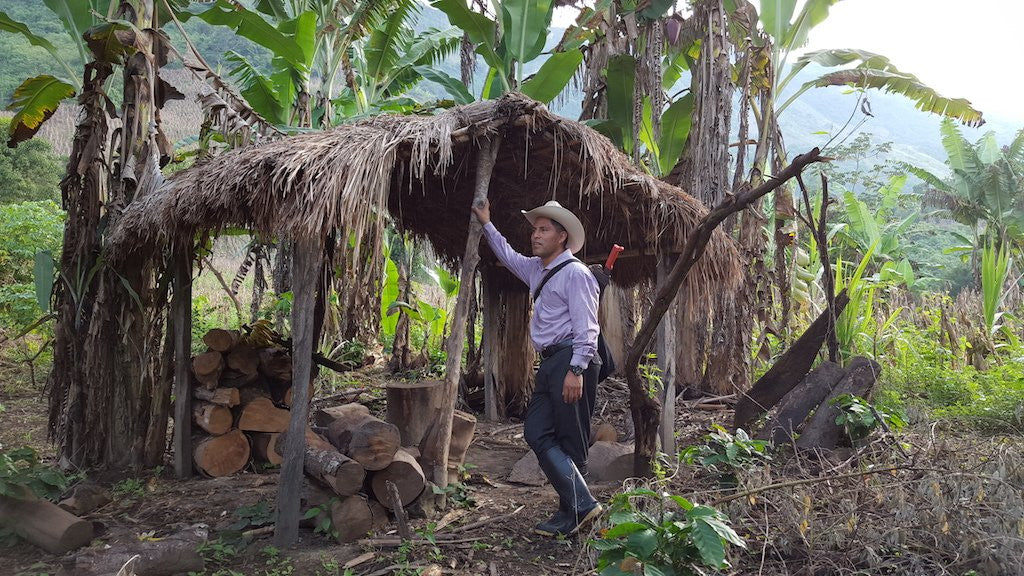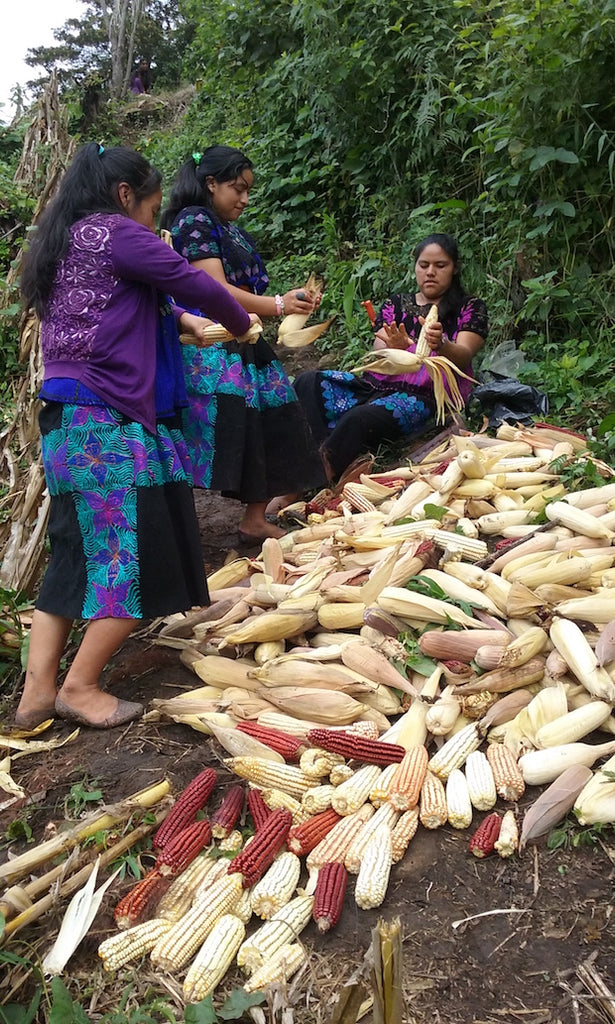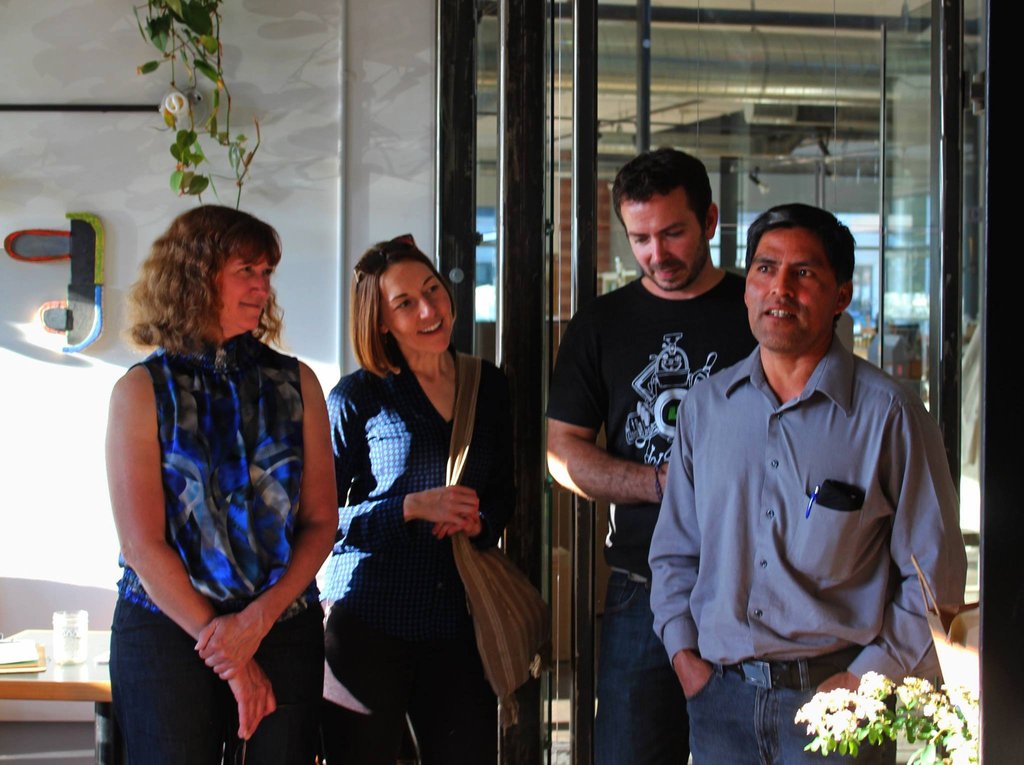
An edited version of this post by Higher Grounds' co-founder & director, Chris Treter, appears in the 12/8/16 edition of Daily Coffee News. Above: Coffee farmer, Jose Perez Vazquez, breaking during the harvest in Chiapas, Mexico, November 2016.
He has walked the corridors of Oslo City Hall as a Nobel Peace Prize nominee, but last December he had his eyes searching the concrete sidewalks of Chicago for change on a brisk dark night. As a founder of Las Abejas Civil Society and Maya Vinic coffee co-op, he's dedicated his life to growing Arabica coffee for the specialty coffee market and organizing his people to preserve his Mayan culture and community. Now he struggled to stave off hunger, unable to afford even a can of black beans.
The man who had inspired me to take on the daily struggle of being a social entrepreneur, 15 years later, was about to usher in a new beginning at Higher Grounds Trading Co.
A week earlier, Jose Perez Vasquez, a 48-year-old Tzotzil Mayan, slung his dirt-stained backpack, filled with the few clothes he owned, around his body and exited Chicago O’Hare International Airport. He just arrived on a one-way ticket from Mexico City purchased with a loan from a Jesuit priest. The same friend who had helped him form his pacifist human rights organization in 1992, the 500 year anniversary of Christopher Columbus’ “discovery” of the “new world,” now helped him overcome his next major life’s hurdle.
The day before, he had messaged me: “I'm coming to Chicago, I want to live with you. Echa me la mano.” He had just realized two years remained on his 10-year visa a week before.
With only $18 to his name, he was ready to take on the present-day conquest faced by coffee farmers around the world. Economic inequality driven deeper by a thirst for the crop he harvested is perpetrated by those in the land he now walked. And now, generational poverty consumers rely on for a reasonably priced morning pick-me-up, was exacerbated by climate change. Coffee farming in Mexico is predicted to become unviable by the end of the 2020s according to the new alarming report by The Climate Institute. He held faith in the word of his coffee roasting buyers at Cooperative Coffees that “partner,” “relationship” and “fair, equitable, and direct trade” actually meant what they should.
“I didn’t know if I would live or die, but our life was so dire, I had no choice but to try to realize mi sueno,” he told me as we sat at the only restaurant we could find open by the time I finally arrived to meet him in Farmington Hills, Michigan two months later. Sullen and sick, his cheeks sunk into his face, exposing the outline of his bones. He had been living off of one small meal a day, and his tiny frame exposed his struggle to acheive his “sueno.”
Migration usually isn't a choice, but rather a desperate need
Unlike my great grandparents, who migrated to the United States in search of a better life from Italy, Slovenia, and Germany, Jose’s journey was to urgently fill his family’s basic human needs to survive. And, like most migrants here in our country, the odds of Jose’s migration northward were extremely high long before he stepped foot on earth; 487 years ago when Spaniard Diego de Mazariegos “founded” Jovel (or San Cristobal de Las Casas as the Spaniards named it), forcing Jose’s ancestors into slavery and serfdom.
Public discourse in the U.S today does not take into account the overwhelming challenges that drive Mexicans reluctantly from families. Nor does it recognize their constant attempts to break free from the very forces that have kept them in poverty for centuries. Coffee provides almost 2% of the annual GDP of the richest nation in the world here in the United States. Yet, as the International Coffee Organization recently declared, “coffee production is not economically sustainable for many producers, and those who can make a profit struggle to cover the costs of establishment and plant renewal.”
Life at the bottom of an unjust, lopsided coffee supply chain was shaped for Jose 169 years ago when Jeronimo Manchinelli planted 1,500 coffee seedlings on his farm in Chiapas, ushering in a new crop. Jose’s ancestors worked the plantations of the foreigners, who then brought seeds home to the highlands to plant in the off season. Today, small farms full of Typica, Maragogype, and Bourbon coffee trees farmed by Tzotzil and Tzeltal families dot the highlands throughout Chiapas.
Jose’s story always has been, unfortunately, not unlike most of the 70% of the world’s 25 million smallholder coffee farmers. In fact, in many places I’ve traveled, the story is even more grim. His family subsists on corn and beans they grow. In a good crop year, the sale of his coffee usually covers the basic survival needs of the family.
As one of the 80.6 percent of Mexico’s indigenous people living in extreme poverty, according to the United Nations’ 2015 report on the status of the world’s indigenous peoples, Jose’s family lacks access to durable flooring material, clean water and sanitation, schools, and health clinics. All of these factors of poverty together create a situation of poor health, lowered life expectancy, and decreased education rates.
Today, the average annual per capita income in Jose’s home region is a third of the state average at just $3,314, similar to that in Africa’s Ivory Coast. Chiapas has the slowest growing economy of any state in the country, with the lowest GDP per capita. Health care, education, and access to potable water are all scarce throughout the indigenous regions.
Lupita, Jose’s 16 year old daughter, had to stop formal education after secondary school. The closest high school is a two hour drive in Yabteclum, a small town that buzzes with combis carting men and women in traditional woven “traje,” identifying the region they call home, back to their villages after a day at the market. Given that there isn’t a car in Jose’s town, and no formal public transportation, Lupita and her siblings, as with Jose and his wife before, don’t have the opportunity to continue their education unless they had the means to move two hours away.
Instead, she spends her days assisting her mother, Juanita, caring for a house of 10 children, their own and those of family who had their lives shortened due to lack of access to health care. (The closest hospital is three hours away in the colonial city of San Cristobal.) Death due to preventable illness is 181 percent higher in rural indigenous areas compared to urban centers in Mexico, and the indigenous live, on average, 5 years less than their fellow Mestizo (of Spanish decent) country folk.

When every last drop of rainwater collected during the rainy system in their rotoplas has been depleted, Lupita helps her mom dig out a small spring, or what appears to you and me as a mud puddle, to gather all the water to cook, drink, and clean with each day. This daily 2-hour ritual is shared with 5 million people in Mexico who do not have access to clean drinking water in their home. They prepare their corn and beans on an open fire on their dirt floor. With lack of adequate acreage to farm and little money now to buy food due to the low coffee harvest, Lupita and her siblings have become part of the 44 percent of indigenous children malnourished in the country,
With an education system that is virtually non-existent in large swathes of indigenous populations, many of which happen to be the coffee growers in Mexico, schools are sparse, and teachers are ill-equipped with limited training, rarely speaking the native language of the community they serve. As a result, only 27 percent of indigenous children graduated from high school in Mexico in 2014, and the illiteracy rate stands at a staggering 44 percent. Only 3% have a university education.
Unfortunately, Jose and his family are the norm, rather than the exception at the bottom of the global coffee supply chain. The poorest 50% of the world’s population owns less than 1% of the world’s wealth. Their wealth has shrunk by 41% in the past five years, while the richest 50% (you and I) claim 99% of the world’s wealth. Meanwhile, adjusted for inflation, the price of a cup of coffee actually costs the consumer less in 2016 than the average cup over the past 50 years.
The birth of Maya Vinic
Our foundational cooperative partner, Maya Vinic, was founded in 1999 by Jose and 500 of his neighbors from 7 municipalities in the Chiapan highlands as a direct response to a horror that had befallen them. “In December 1997, in the town of Acteal—the area where I live—45 people attending a prayer meeting were shot dead by Mexican paramilitary members. The victims included my friends and family, pregnant women, and children. In response, the Maya Vinic Cooperative was founded as a way for us coffee farmers to protect ourselves, share resources, and make a pledge for peace,” Jose explains in a guest blog he penned for us. “Their blood gave us the strength to organize, to face new experiences, and ultimately to found our co-op.”
Since then, Higher Grounds has grown from selling Maya Vinic’s coffee at a farmer’s market, in 2002, to a staff of twenty who roast, package and ship that coffee all over the country. We've purchased over 300,000 pounds of coffee from Maya Vinic at a premium above the fair trade, organic minimum. We’ve incorporated direct, ethical buying practices with development work while collaborating with other coffee roasters and engaging our consumer network to foster long community impact with the co-op.

Above: Coffee farmer, Jose Perez Vazquez, speaks at a latte art throwdown in Traverse City, Michigan, June 2016.
With other roasters at Cooperative Coffees and consumer donations via On the Ground, we’ve provided funded the construction of potable water systems in Maya Vinic communities and fed a multitude of refugee families and provided over $65,000 to combat coffee rust.
On top of that, Higher Grounds has donated 15 cents for every pound purchased before coffee rust hit to help construct a macadamia nut nursery, start a cafe, and build a restaurant.
Hundred of coffee buyers, consumers, activists, high school and college classes, have attended our delegations to Chiapas to participate in skill-building activities and learn about “sustainable” coffee production and “fair and direct” trade. Attendees have become allies who continue to provide project support long after their trip. Nearly a hundred community members are now trained to maintain water systems once they’re flowing to each home. We’ve taught children of farmers how to play musical instruments and left behind guitars, and provided coffee farmers with skills to improve quality and increase profits.
This international multi-faceted relationship equates to dollars in Jose’s pocket. “Now, we have been able to build a bridge for direct communication between producers and coffee consumers, The good price that we obtain for our coffee translates into profits that we share equally at the end of every harvest season.”
But all of that “impact” hasn't changed the stark realities of the farmers we profess to be in a “fair and equitable” relationship with, I increasingly feel, as I order him a chicken sandwich and extra order of fries to compensate for being four hours late to take him out for his only meal of the day. Life for him, here in Farmington Hills, must be one of constant contrast.
On top of his daily struggle of poverty, I learn that Jose was literally scrambling to deal with the very real impact of climate change. And it came in the form of “la roya,” or coffee rust, three years ago. Last year, it delivered a life-altering blow.
Maya Vinic’s 2015 harvest had been estimated to be 120 tons of exportable coffee, nearly a container of which was designated to Higher Grounds. By the time the harvest rolled around, only 69 tons of coffee was collected. Jose had already spent two years wracking his brain, trying to figure out how to get the resources necessary to care for his family as climate change induced la roya wreaked havoc on his coffee fields. With almost half of his crop destroyed, Jose had no choice but to migrate to Mexico City in search of work.
Buyers' “relationship” with origin is never static
As our server cleared Jose’s crumbless plate, and one with a half eaten hamburger from me, I knew something had to be done. Jose was a “partner” at our specialty coffee roasting company, Higher Grounds Trading Co. and our “relationship” with him and Maya Vinic spans the lifetime of our company. I, along with fellow roasters of Cooperative Coffees, had traveled with him throughout the Midwest in 2004. His meager frame and his hushed tone did not match him to the farmer featured in Connected by Coffee, a documentary that followed myself and fellow Co-op Coffees member Matt Earley of Just Coffee Co-op through Central America, visiting our coffee growing partners in 2013 just as la roya reared its wicked head in Nicaragua and began to creep northward.

Jose and I have stood before thousands of consumers of Maya Vinic coffee in the 15 years since we first began our trading relationship, exposing the importance of supporting equitable trading models such as ours. On kitchen counters across the country, consumers pick up our 12 oz. bag of Maya Vinic coffee and see a picture of Jose and me giving each other a high five in his coffee field.
Yet this cold, damp evening, in a random suburb of Detroit at a chain restaurant I'd never otherwise visit, sipping the last of our Coca Cola as the servers swept the floors, waiting for us to leave, I sat beside a man who was clearly not in a healthy “relationship” with the largest customer of the business he founded, working within an industry that celebrates this “relationship” as ethical and innovative.
And, it became very clear that our “relationships” and “sustainability” initiatives—though providing much needed pre-financing, support for renovation of coffee fields and technical assistance, purchasing coffee even above direct trade, fair trade and/or organic premiums, and putting profits back into farmer led community projects—do not provide families with the basic human needs necessary to sustain their livelihoods.
And if those coffee farmers in Mexico, or anywhere else, were cherry farmers in Traverse living in dire conditions, the market would have long before called ours, and every other company in the coffee industry, out. The consumer wouldn’t be able to live with the fact that their neighbors lived without the basic human needs, let alone comforts, they all enjoy. It was time to reevaluate the nature of the top-down “relationship” prevalent in the specialty coffee industry. And time to show Jose that “sustainability” for Higher Grounds, was not simply built upon his ability to produce more coffee.
“I have a dream too, Jose,” I told my friend across the table. “Maybe you can help me with mine, and I can assist you with yours.”
Little did I know that those words would begin a nine-month adventure that would see us taking on the buyer bias of the U.S. specialty coffee industry, an unprecedented rise of xenophobia in our country, and an international drug cartel to save lives of those not as fortunate as Jose.
